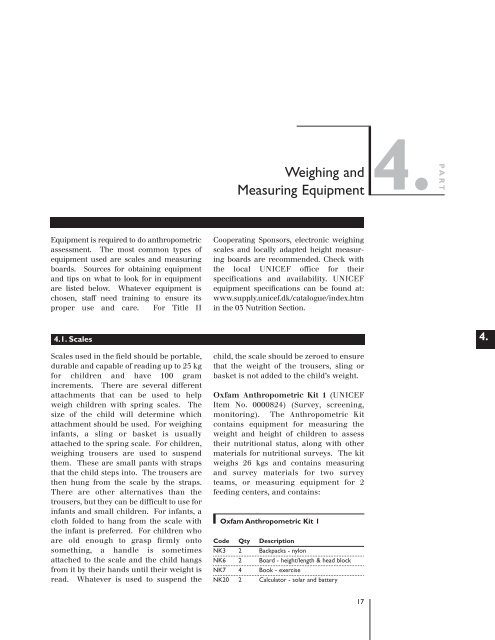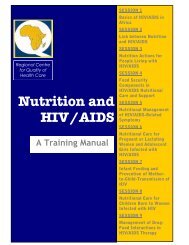2.1: Anthropometric Indicators Measurement Guide - Linkages Project
2.1: Anthropometric Indicators Measurement Guide - Linkages Project
2.1: Anthropometric Indicators Measurement Guide - Linkages Project
You also want an ePaper? Increase the reach of your titles
YUMPU automatically turns print PDFs into web optimized ePapers that Google loves.
Weighing and<br />
Measuring Equipment<br />
4.<br />
P ART<br />
Equipment is required to do anthropometric<br />
assessment. The most common types of<br />
equipment used are scales and measuring<br />
boards. Sources for obtaining equipment<br />
and tips on what to look for in equipment<br />
are listed below. Whatever equipment is<br />
chosen, staff need training to ensure its<br />
proper use and care. For Title II<br />
Cooperating Sponsors, electronic weighing<br />
scales and locally adapted height measuring<br />
boards are recommended. Check with<br />
the local UNICEF office for their<br />
specifications and availability. UNICEF<br />
equipment specifications can be found at:<br />
www.supply.unicef.dk/catalogue/index.htm<br />
in the 03 Nutrition Section.<br />
4.1. Scales<br />
4.<br />
Scales used in the field should be portable,<br />
durable and capable of reading up to 25 kg<br />
for children and have 100 gram<br />
increments. There are several different<br />
attachments that can be used to help<br />
weigh children with spring scales. The<br />
size of the child will determine which<br />
attachment should be used. For weighing<br />
infants, a sling or basket is usually<br />
attached to the spring scale. For children,<br />
weighing trousers are used to suspend<br />
them. These are small pants with straps<br />
that the child steps into. The trousers are<br />
then hung from the scale by the straps.<br />
There are other alternatives than the<br />
trousers, but they can be difficult to use for<br />
infants and small children. For infants, a<br />
cloth folded to hang from the scale with<br />
the infant is preferred. For children who<br />
are old enough to grasp firmly onto<br />
something, a handle is sometimes<br />
attached to the scale and the child hangs<br />
from it by their hands until their weight is<br />
read. Whatever is used to suspend the<br />
child, the scale should be zeroed to ensure<br />
that the weight of the trousers, sling or<br />
basket is not added to the child’s weight.<br />
Oxfam <strong>Anthropometric</strong> Kit 1 (UNICEF<br />
Item No. 0000824) (Survey, screening,<br />
monitoring). The <strong>Anthropometric</strong> Kit<br />
contains equipment for measuring the<br />
weight and height of children to assess<br />
their nutritional status, along with other<br />
materials for nutritional surveys. The kit<br />
weighs 26 kgs and contains measuring<br />
and survey materials for two survey<br />
teams, or measuring equipment for 2<br />
feeding centers, and contains:<br />
Oxfam <strong>Anthropometric</strong> Kit 1<br />
Code Qty Description<br />
NK3 2 Backpacks - nylon<br />
NK6 2 Board - height/length & head block<br />
NK7 4 Book - exercise<br />
NK20 2 Calculator - solar and battery<br />
17

















